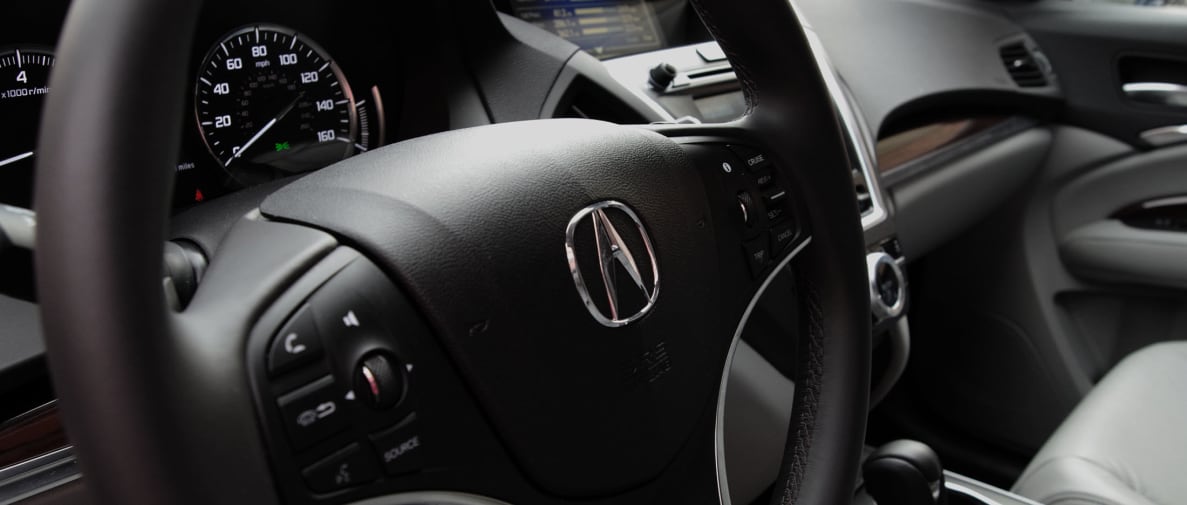Full-size crossovers always seemed to lack both the go-anywhere utility of an SUV and the efficiency of a wagon or minivan. But the all-new 2014 Acura MDX (starting MSRP $42,290, $48,565 as tested) presented the most compelling case I've seen against buying a more sensible vehicle.
Unlike many of its competitors, the MDX actually offers some utility gains over smaller vehicles. There's room for seven passengers, and the rearmost seat is spacious enough that even fully-grown adult humans will find enough legroom for a short trip.
{{ photo_gallery name="Exterior Gallery" }} Of course both rows of rear seats fold down for cargo storage. But accessing the rearmost seats is shockingly easy: Press a button, and the second row will automatically slide forward and fold for easy ingress and egress. Once you're in the back, just press another button and the second row seats assume their original positions.
While a minivan offers better access, the MDX's setup is fine for occasional trips with sixth and seventh passengers—especially if those passengers are kids. If little ones are a high priority, be sure to check out the Infiniti QX60's cool Latch and Glide seats, where the second row can slide forward even when a child safety seat is safely anchored in place.
The two-wheel drive MDX is also efficient. With front-wheel drive, it beats the Honda Odyssey minivan by a mile per gallon in city and combined fuel economy, while the all-wheel drive MDX only loses a mile per gallon combined compared to Honda's front-wheel drive minivan. In a combination of city and highway driving, I recorded an average of 21 mpg in an all-wheel drive MDX.
One of those jaunts was a trip from Boston to New York to cover the 2014 New York Auto Show, the same event where the MDX debuted just a year earlier.
I ended up driving into the city at night during a torrential downpour, and was grateful for all-wheel drive. Those "Jewel Eye" LED headlights may look gimmicky on a sunny day, but when it's next to impossible to see already faded lane lines, a clear beam of crisp, white light helps.
{{ photo_gallery name="Interior Gallery" }} On the road, I found the MDX more dynamic than the five-passenger Lexus RX, but not quite as nimble as Infiniti's seven-passenger QX60. Still, as long as I set the Integrated Dynamics System (IDS) to "Sport" for quicker steering and a more lively throttle response, the MDX was plenty enjoyable to drive. Unfortunately, the IDS would default to "Normal" when the car was turned off.
Whether I was dodging cyclists, pedestrians, and taxis in the city or changing lanes in highway traffic, the MDX never felt too big. Visibility was fine—I had no problems parallel parking with a little help from the rear view camera, and merging into traffic didn't require an act of faith.
About the only fundamental problem with the MDX is its dreadful AcuraLink infotainment system. Like most other Honda and Acura products, AcuraLink splits navigation and audio across two screens, one of which doubles as a haptic touchscreen and competes with a clickwheel for user input.
{{ photo_gallery name="TECH Gallery" }} Not only is the split system confusing to operate, but a labyrinth of similar-sounding menu options makes it easy to get lost even before you enter a destination. To get cloud-based navigation, you have to sign up for AcuraLink's Connect service for $249/year, but connectivity to Yelp, TripAdvisor, and streaming audio from Aha are free for the first three years of ownership and $49/year thereafter. You just need to download the AcuraLink app on your iOS or Android smartphone.
Clunky graphics put AcuraLink generations behind more advanced setups from the likes of GM and Toyota, and it will look even more dated when Apple's CarPlay finally debuts.
Tech aside, the MDX is still a pretty compelling argument against buying a minivan. But the Town & Country, Sienna, and Odyssey will always win on one point: price. Even if you skip the AcuraLink infotainment system—which, bundled with premium audio and collision avoidance tech, adds around $4,000 to the car's base price—the MDX is always about $10,000 more than a comparable minivan.
The Toyota Sienna, for instance, offers all-wheel drive and seating for eight. Fully loaded, it costs $36,185. A similarly-equipped MDX is just north of $48k, and rear-seat entertainment will push that price even higher.
For most families, $10,000 could be better spent on college, diapers, or a few years of amazing vacations. But if you've got the disposable income and prefer a crossover to a minivan, the MDX is about as versatile as they come.
Meet the tester
Keith was the Editor in Chief of Reviewed's appliance and automotive sites. His work has appeared in publications such as Wired, Car & Driver, and CityLab.
Checking our work.
Our team is here for one purpose: to help you buy the best stuff and love what you own. Our writers, editors, and lab technicians obsess over the products we cover to make sure you're confident and satisfied. Have a different opinion about something we recommend? Email us and we'll compare notes.
Shoot us an email


